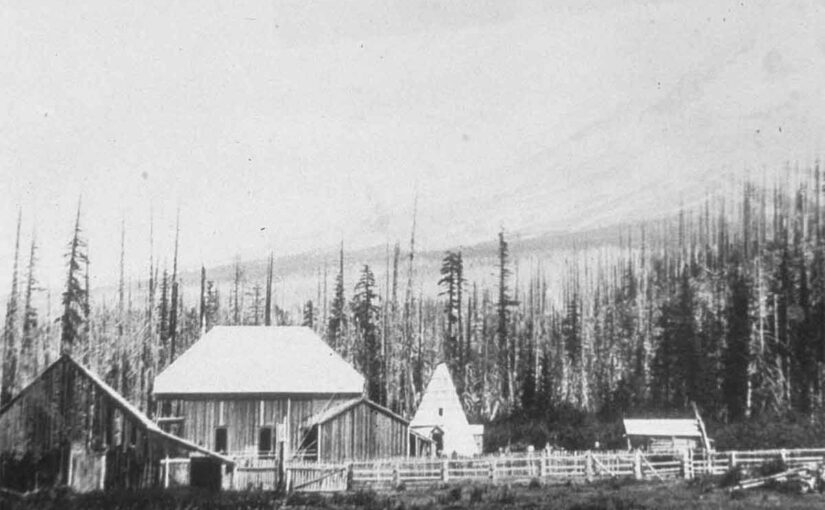The Historic Gravesites at Summit Meadow
A Legacy of the Oregon Trail
Near Government Camp, Oregon, within view of Mount Hood, at the Summit Meadow Pioneer Cemetery, a small white picket fence encloses three pioneer graves. These simple markers remind visitors of the dangers faced by emigrants traveling the Barlow Road, the final and most treacherous stretch of the Oregon Trail. Though many call it a cemetery, it is not an official burial ground. Instead, it holds historic gravesites, marking the final resting places of some of Mount Hood’s earliest travelers.
A Resting Place Along the Barlow Road
In 1846, Samuel Kimbrough Barlow carved out an overland route around the Columbia River Gorge. This trail became known as the Barlow Road, an alternative to the dangerous river route. However, the journey remained treacherous.
As they crossed over the south shoulder of Mount Hood, pioneers used Summit Meadow as a final place to rest and recover while crossing before the final stretch to the Willamette Valley. Unfortunately, some never left. As a result, families buried those who perished in the meadow’s soft ground.
The Graves at Summit Meadow Pioneer Cemetery
Inside the white picket fence, are three stones marking three graves. One belongs to Baby Barclay, the infant son of W.L. Barclay and his wife, immigrants who were camped at Summit Meadow in September 1882. The child had been born on the trail in July that year and was ill. He died at Summit Meadow. Another marks the grave of local legend Perry Vickers. According to local stories, Perry Vickers helped bury the Barclay child, even building a small wooden box for the burial. A third, unmarked gravestone stands next to them. It is believed to be the grave of a girl named Hannah Bond who was buried by her father there in 1853.
Baby Morgan Memorial
Just outside the fenced area, another stone plaque honors Baby Morgan. In October of 1847, an infant known only as Baby Morgan died while traveling the Oregon Trail with her family near Mount Hood. The daughter of Daniel and Rachel Morgan, she was born shortly after her mother died from illness on the trail in Wyoming. As the wagon train neared Oregon, the baby was injured during travel and passed away near what is now Summit Meadow. She was buried beside a distinctive rock said to resemble “house and chimney”. A landmark later used by descendants to locate her grave.
Today, a bronze plaque marks the site, honoring her as one of the Oregon Trail’s youngest pioneers. This grave is significant due to its connection with the early Barlow Trail established just a year before.
Although these are the only visible graves, they represent countless unnamed pioneers who never reached Oregon’s fertile valleys who lie in unmarked graves along the way.
Perry Vickers: A Mount Hood Legend
Among the graves rests Perry A. Vickers (1845–1883), an early settler, mountaineer, and innkeeper. He arrived in Oregon in 1865 and built Summit House, a way station for weary travelers along the Barlow Road. His lodge offered food, supplies, and shelter to those crossing the mountains.
In addition to running the lodge, Vickers became Mount Hood’s first known climbing guide. In 1870, he lit bonfires near Illumination Rock, hoping people in Portland could see them. Because of this, he helped promote Mount Hood as a climbing destination.
Tragically, his life ended in 1883. While serving on a posse, he was shot and killed. To honor his legacy, his final resting place became his beloved home at Summit Meadow, where he had spent much of his life helping others.
The White Picket Fence
A white white picket fence surrounds these graves, there is no entrance. The lack of a gate or walkway reinforces that this was never a formal cemetery. Instead, it serves as a memorial, preserving the history of a few Barlow Trail pioneers.
A Reminder of Oregon’s Pioneer Past
The gravesites at Summit Meadow Pioneer Cemetery offer a glimpse into Oregon’s pioneer era. More importantly, they remind visitors of the sacrifices, struggles, and stories of those who made the journey west.
Even though the markers are few, their significance remains powerful. Ultimately, they tell the story of hope, hardship, death and survival in Oregon’s early days

